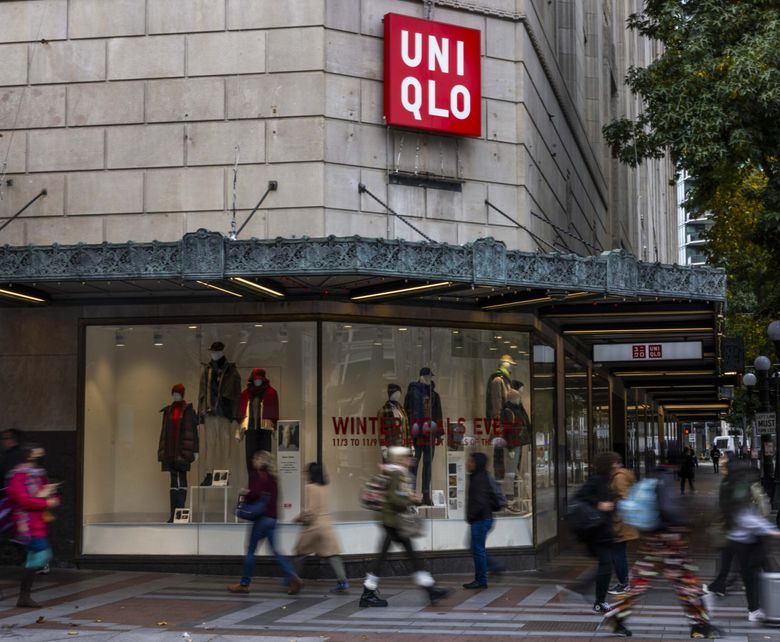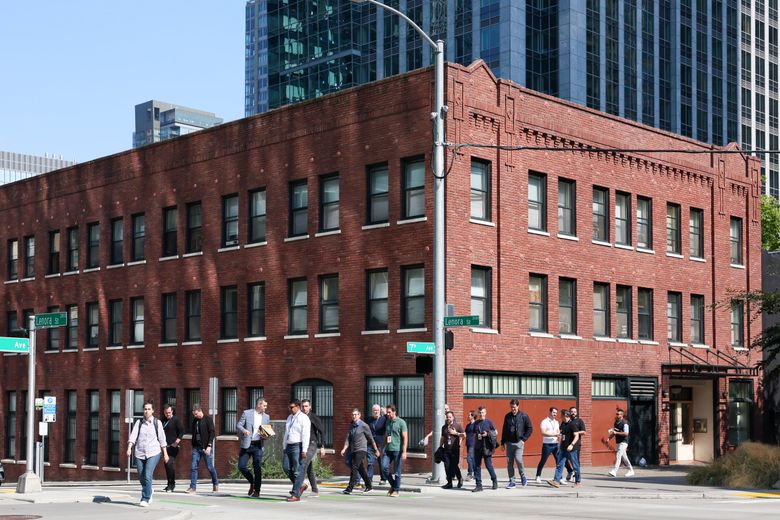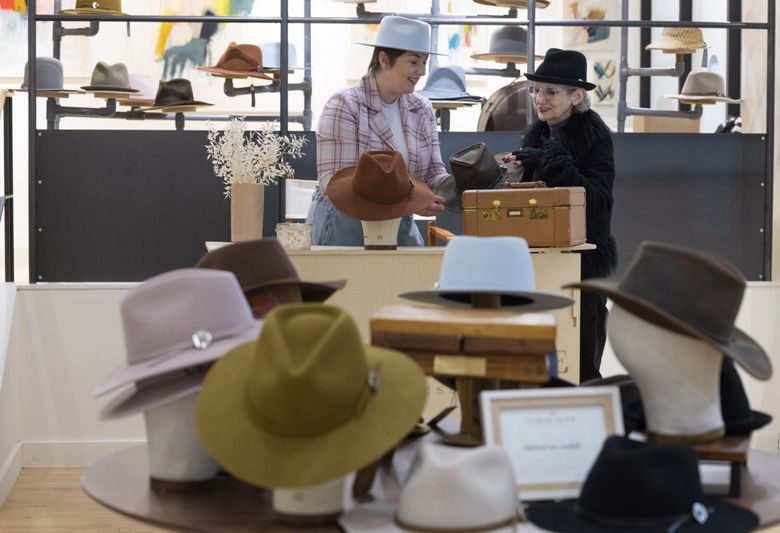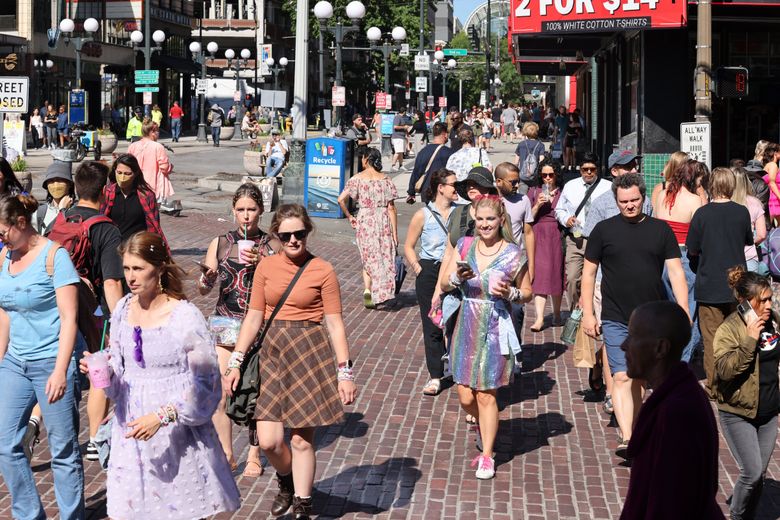News
The Seattle Times: Businesses are making big bets in downtown Seattle, despite it all
Posted on

This story was originally published in The Seattle Times on Nov. 19, 2023.
If downtown Seattle ever truly recovers from COVID-19, it will be thanks in large part to a new wave of risk-takers like Jason Lemons.
In June, Lemons, 43, opened The Lemon Grove, a vintage clothing and household accessories store in Pioneer Square. Although the historic neighborhood still wasn’t back to its pre-pandemic normal, Lemons and partners Maria Rountree-Olivares and Ian Rountree saw potential.
Weyerhaeuser and other neighborhood employers were bringing workers back. Stadium events like the All-Star Game and Taylor Swift concerts would generate massive foot traffic.
Most important, because so many businesses left during the pandemic, rents were low. Lemons was able to find a 2,100-square-foot storefront on South Jackson Street, in the heart of the Pioneer Square arts scene, for a price that gives him some breathing room.
“It felt like an opportunity that wouldn’t come up again,” Lemons said, standing amid racks of clothing from the 1990s and before. “So I was just like, ‘Let’s do it.’ I just rolled the dice.”
Lemons isn’t the only entrepreneur doubling down on a downtown revival.
Over the past year or so, dozens of retailers, restaurateurs and other businesses have been betting that Seattle’s economic center will come back from a pandemic that emptied offices, exacerbated crime and homelessness, and left blocks of boarded windows and “For Lease” signs.
These gamblers run the gamut, from local players like Lemons to big-time brands like Uniqlo, the Japanese retailer that opened in the old Bon Marché/Macy’s building last fall, and Arc’teryx, which is moving from its space at Fourth Avenue and Pike Street to a much larger one across the street next spring.

All told, since October 2021, more than 100 shops, restaurants and other businesses have opened or reopened in downtown Seattle, or have committed to in the near future, according to the Downtown Seattle Association. That compares with 281 openings between January 2020 and September 2021 cited in a 2022 DSA report.
Large or small, the recent openings all represent some confidence about a core Seattle neighborhood that, nearly four years after COVID struck, is still known mainly for losing businesses, notably NikeTown, which exited in January, and PCC Community Markets, which just announced it will leave downtown early next year.
“We’re very bullish on downtown locations like Seattle,” says Kevin Miles, CEO of California-based restaurant chain Mendocino Farms, which opened two downtown locations this year, including in Rainier Square at Fourth Avenue and Union, near PCC, that Miles said is already 20% ahead of sales projections. “We’ve really outperformed.”
Over at Ben Bridge Jeweler, which recently moved from its 94-year-old location at Fifth Avenue and Union Street to a larger store on Pine Street across from Nordstrom, CEO Lisa Bridge puts it more bluntly: “We’re putting our money where our mouth is.”
Still in the hole
To be clear, downtown Seattle’s recovery has a very long way to go — and some parts may never look like they did in 2019.
While high-profile challenges such as crime and homelessness have lessened since the height of the pandemic, downtown’s business community is deeply scarred.
According to CoStar, a commercial real estate data analytics firm, as of September, nearly 14% percent of the retail space is vacant in downtown’s central business district, which CoStar defines as running from Denny Way south to Yesler Way, and excluding Belltown and the waterfront.
That’s a more than sixfold increase from 2019 — and well above the peak of 8% in the Great Recession. It’s also six times the current retail vacancy rate in downtown Bellevue and two and a half times the rate in downtown Tacoma, according to CoStar.
In the 12-block commercial core between Olive Way and Union Street and Third and Sixth avenues, more than half of the retail spaces appeared to be either vacant or partially vacant as of May, according to the city’s Office of Planning and Community Development.

While downtown vacancy may be “plateauing in the short to midterm,” refilling those empty shops won’t happen fast, says Elliott Krivenko, CoStar’s director of market analytics in Seattle. “It’s a lot of space to work through.”
For starters, the long-awaited return to office continues to lag.
Although some big employers like Amazon and Weyerhaeuser have brought workers back, worker presence downtown is still only around half of pre-pandemic levels, according to data posted by Downtown Seattle Association. Overall foot traffic downtown has averaged less than 80% of pre-pandemic levels for more than a year.
As important, even if office workers return, downtown must still win back the shoppers it was losing before COVID to online competitors as well as regional rivals like Bellevue Square, Westfield Southcenter and University Village.
If anything, pandemic-related closures merely accelerated an already-vicious cycle, says Jeff Green, a retail analyst with Hoffman Strategy Group who follows Seattle. “If there’s less retail downtown, what is the reason to go there?”
If anything, pandemic-related closures merely accelerated an already-vicious cycle, says Jeff Green, a retail analyst with Hoffman Strategy Group who follows Seattle. “If there’s less retail downtown, what is the reason to go there?”

Not just one downtown
Downtown Seattle isn’t a single monolithic retail market, and the business climate is often better even a few blocks outside the core business district. In South Lake Union, where Amazon workers now crowd the streets again at lunch, retail vacancy is only around 3.9%.
Nor are office workers the only spenders. Tourism has recovered much faster than offices have: Out-of-town domestic visitors to downtown are back at nearly 90% of pre-COVID numbers and hotel demand is actually higher than before, according to Downtown Seattle Association data. That recovery is likely to accelerate with the opening of the city’s new waterfront in 2025.
As well, downtown’s residential population has been quietly booming; if you include areas adjacent to downtown area, it’s up 16% just since 2019, to 106,000, according to data firm Esri.
Both tourists and residents help explain why retail vacancies are also just 4% in Pioneer Square and the waterfront area.
“A lot of new things have reopened or opened, just in the last month, which is super encouraging,” says Jason Wolfe, 46, a Pioneer Square area resident of six years. “You definitely see folks coming back … going to the stadiums, going out.”
Business is also up for many waterfront-area businesses, with restaurants in particular “exceeding their pre-pandemic numbers, which were already really strong,” says Jason Miller, who oversees retail leasing in the Seattle office of commercial real estate firm Kidder Mathews.
Tourism’s recovery has been good news for nearby retailers like Peter Gaučys and Patrick Angus, who opened their upscale gift shop, Orcas Paley, in the Moore Hotel on Second Avenue, just up from Pike Place Market, in June.
Although the shop, which was founded in Hillman City almost five years ago, arrived with an established customer base, sales in the new location have been boosted by “people visiting the Market, people staying in the Moore,” Gaučys says.
Likewise for Ben Bridge. It posted its best-ever downtown sales for October, in part, Lisa Bridge speculates, because cruise passengers and other tourists are helping make up for missing office workers.
A reviving downtown theater and music scene is also encouraging businesses to venture back into downtown.
Seattle restaurateur Ethan Stowell decided to open his new Bombo Italian Kitchen in the new Seattle Convention Center in June in part because of coming shows at the Fifth Avenue and Paramount theaters and events at the center itself.
During a single three-day convention event in September, Bombo “sold 2,500 pizzas, $110,000 in food and beverage,” Stowell says. “It was crazy.”
The price is right
Other factors are giving businesses the confidence to go downtown.
Many business owners pointed to the city’s continued efforts to move homeless people into shelters and dismantle tent encampments, as well as a new law against public drug use and drug possession that went into effect in October.
In October, the number of observed encampments within the 300-block downtown Metropolitan Improvement District averaged 21, down from a peak of 146 in January 2021, according to data from Downtown Seattle Association. The association manages district programs, budget and staff, including 124 Downtown Ambassadors who handle cleanup, conduct homeless welfare checks and assist tourists and visitors.
Retail theft and open-air drug use remain problems, but overall crime rates are down.
Violent crime in the central business district, Belltown, Chinatown International District and Pioneer Square from January through September was down 14% compared with the same period in 2022, according to Seattle Police Department statistics. Theft and other property crime was down 29%.
Business owners also credit efforts by the city and organizations like the Downtown Seattle Association and the Alliance for Pioneer Square to clean up the streets and support new businesses.
A program called Seattle Restored, for example, uses city funds to turn empty storefronts into rent-free pop-ups — two dozen so far — for businesses looking for a foothold downtown and in other neighborhoods.

“It’s been an incredible opportunity,” says Jamie Slye, who opened her hat shop in a Seattle Restored pop-up near the 5th Avenue Theatre last spring.
Slye, who had primarily sold either online or through other retailers, has used the temporary space to both test the downtown market and “learn about having a retail spot.”
Downtown’s depressed real estate market is creating other business opportunities.
As vacancies have risen, many businesses have been able to negotiate generous lease deals that can range from free months’ rent to “percentage” arrangements that link rents to tenants’ monthly revenue. “Landlords are definitely doing everything they can to attract and to keep tenants,” Kidder’s Miller says.
Price breaks have been especially critical for smaller businesses, which might otherwise not have ventured downtown.
A sweet lease deal “was a huge factor” for Jeffrey Long, 59, who is opening Long Brothers Fine and Rare Books in Pioneer Square in the next few weeks after years of doing business primarily online.
Long got a corner storefront at the South Jackson and Occidental Avenue South for 25% less than space he’d looked at in Georgetown that was the same size but “certainly didn’t have the prominence and visibility of the space I have.”
New businesses are also seeing another, even more perverse economic advantage: much of the competition was wiped out by COVID.
Stowell, for example, thinks a big reason his downtown restaurant Cortina is busier than before COVID is that downtown diners today have “significantly fewer options.”
Waiting and seeing
Still, if cheap rents and fewer competitors mean opportunity for downtown’s pioneers, they also reflect the lasting uncertainty of an unpredictable recovery.
Some newcomers think they can thrive even if that recovery is protracted.
That includes Suitsupply, the Holland-based men’s suit and fashion chain, which is opening a new 4,300-square foot store in Rainier Tower next spring. Though office workers are a key market, Suitsupply doesn’t need them back in the office full time.
“At the end of the day, it doesn’t matter for us if they are in the office five days a week [or] three days a week,” CEO Fokke de Jong says. Many of those workers will still need suits for “when they go to their business meetings, their events, their receptions.”
For other business newcomers, downtown still feels like a complicated experiment that hasn’t yet proved out.
Slye, the hat shop owner, says foot traffic has been so unpredictable she isn’t sure yet whether a downtown location makes sense for her business. Like many newcomers, Slye thinks the holidays will be a crucial test. “Will it still be primarily tourists [or] will people that live in Seattle be coming … downtown?” she says.
Lemons, too, has yet to see what a full year looks like downtown. Although the shop has enjoyed strong sales since opening, he says, “What happens when the tourists stop, foot traffic dies down [and] the weather turns?”


Stephanie King has juggled that uncertainty for two years. In late 2021, King and her partners plunked down $1.4 million to open Kitchen & Market, a European-style grocery store, in a 5,000-square foot space in Pike Place Market.
Although sales have grown steadily, they’re still half of what King projected.
King has time. Sales are strong at two newer locations, on Mercer Island and in Medina. King has also been able to cut costs at her Pike Place store while she comes up with ways to reach more of her neighborhood’s year-round residents.
In the meantime, King is steadily building sales by partnering with fellow downtown entrepreneurs, including carrying other businesses’ products in all her shops. She also tries to nurture reciprocity among neighboring businesses by making sure that she and her staff patronize local shops.
“Right now is such a pivotal moment for everybody that works or lives downtown,” King says. “This is truly that moment where every dollar counts.”
Paul Roberts: proberts@seattletimes.com; on Twitter: @Pauledroberts.